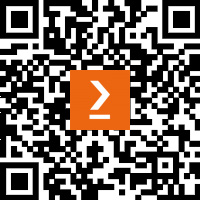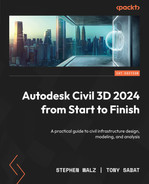Preface
Autodesk Civil 3D connects to an entire network of other software to take your project farther than you would imagine for civil engineering design. You will be able to put your knowledge to work with this practical guide on civil engineering design. This book provides a hands-on approach to implementation and associated methodologies that will have you and your team functional and productive in no time.
This book covers all the major features Civil 3D has to offer, whether surface development, intelligent utility design, or dynamic display work for creating smart documentation. You’ll learn how best to configure and manage your civil engineering designs by successfully leveraging all that Autodesk Civil 3D has to offer. You’ll then learn how to practically apply the tools and modeling techniques available within the software.
By the end of this book, you will have a thorough understanding of Autodesk Civil 3D, along with its partner programs, and be able to strategize how best to utilize it on your next project.
Who this book is for
This book is for civil engineers, environmental engineers, surveyors, civil designers, civil technicians, Civil 3D professionals, and InfraWorks professionals looking to understand how to best leverage Civil 3D in their everyday designs.
You’ll need to have a very basic understanding of civil engineering and surveying workflows, as well as a foundational understanding of Autodesk’s AutoCAD, to make the most of this book. A basic understanding of surveying, civil/environmental engineering practices, and AutoCAD drafting knowledge is assumed.
What this book covers
Chapter 1, Introduction to Civil 3D, begins by exploring the program itself. This is where the main tools are, and you will familiarize yourself with the working space. We will explore the user interface and review where objects are stored as they are created.
Chapter 2, Setting up the Design Environment, reviews how work is logged and integrated as more complexity is added. We will explore how modeled components and geometry can be affected by dynamic display styles and how to create a new file for a design project.
Chapter 3, Sharing Data within Civil 3D, demonstrates the power of Civil 3D as a program, not only showing how to design a basic project in Civil 3D but also how to scale your workflows to include more team members for larger project sizes while maintaining efficiency.
Chapter 4, Configuring Survey Data with Civil 3D, contains all you need to know about bringing in existing survey data with proper formatting and how to establish an accurate depiction of a yet-to-be-designed project site, given that civil design always begins with existing conditions.
Chapter 5, Leveraging Points, Lines, and Curves, dives into the application and intersection of Civil 3D’s tools, now that we understand the basic tools and methods, to better develop a confident infrastructure design. Civil 3D is a dynamic program that not only makes use of intelligent components and design processes but also integrated workflows that adjust when dependent parts of the design adjust or change, which results in less time spent recreating work or formatting when work is updated automatically.
Chapter 6, Surfaces - The First Foundational Component to Designs within Civil 3D, elaborates on one of the three foundational modeling elements, which is surface modeling, required for almost every civil engineering-related design.
Chapter 7, Alignments - The Second Foundational Component to Designs within Civil 3D, is all about the second foundational modeling element required, which is alignments, pertinent to almost every civil engineering-related design.
Chapter 8, Profiles - The Third Foundational Component to Designs within Civil 3D, explains the third and final foundational modeling element, which is profiles, as it applies to almost every civil engineering-related design.
Chapter 9, Land Development Tool Belt for Everyday Use, involves putting on our Land Development Tool Belt and jumping into the world of subdivisions, parks, and overall civil site design.
Chapter 10, Roadway Modeling Tool Belt for Everyday Use, has us put on our Roadway Modeling Tool Belt and jump into the world of transportation.
Chapter 11, Advanced Roadway Modeling Tool Belt for Everyday Use, continues to expand upon our Roadway Modeling Tool Belt and jumps into advanced applications to transportation.
Chapter 12, Utility Modeling Tool Belt for Everyday Use, walks through a final specialized set of tools, the Utility Tool Belt, and jumps into the world of utility infrastructure, which ultimately services our communities and land.
Chapter 13, Section Creation and Analysis, reviews how to create, display, and manage Section Views within Civil 3D.
Chapter 14, Automating Sheet Creation, teaches you how to automate sheet creation and migrate your design from a modeled state to a true design deliverable.
To get the most out of this book
|
Software/hardware covered in the book |
Operating system requirements |
|
Autodesk AutoCAD |
Windows or macOS |
|
Autodesk Civil 3D |
Windows or macOS |
If you are using the digital version of this book, we advise you to use the datasets available as you work through each chapter. Instructions are available within the chapters that detail whether readers will need to create a new drawing from scratch or open a file that has already been prepared. Doing so will help you follow the steps outlined.
Disclaimer
To ensure that a timely publication of this book’s content is in close alignment with Autodesk’s product release cycle, you may notice as you progress through our Civil 3D 2024 learning journey that there are several images displayed in referenced Figures that depict an earlier release of Civil 3D. It’s important to note that features and workflows discussed throughout this book are still relevant and applicable in Autodesk’s Civil 3D 2024 product and in which we will be applying throughout our learning journey.
Download the exercise files
You can download the exercise files for this book at https://packt.link/UoiPn
Download the color images
We also provide a PDF file that has color images of the screenshots and diagrams used in this book. You can download it here: https://packt.link/2lHjT.
Conventions used
There are a number of text conventions used throughout this book.
Code in text: Indicates code words in text, database table names, folder names, filenames, file extensions, pathnames, dummy URLs, user input, and Twitter handles. Here is an example: “Please note that if your design references metric units, you can select the _Autodesk Civil 3D (Metric) NCS.dwg drawing template to ensure that correct units are applied to your drawing.”
Bold: Indicates a new term, an important word, or words that you see onscreen. For instance, words in menus or dialog boxes appear in bold. Here is an example: “Any time you create a new drawing by going to Menu Browser and selecting New | Drawing, a dialog box will appear for you to select the drawing template.”
Tips or important notes
Appear like this.
Get in touch
Feedback from our readers is always welcome.
General feedback: If you have questions about any aspect of this book, email us at [email protected] and mention the book title in the subject of your message.
Errata: Although we have taken every care to ensure the accuracy of our content, mistakes do happen. If you have found a mistake in this book, we would be grateful if you would report this to us. Please visit www.packtpub.com/support/errata and fill in the form.
Piracy: If you come across any illegal copies of our works in any form on the internet, we would be grateful if you would provide us with the location address or website name. Please contact us at [email protected] with a link to the material.
If you are interested in becoming an author: If there is a topic that you have expertise in and you are interested in either writing or contributing to a book, please visit authors.packtpub.com
Share Your Thoughts
Once you’ve read Autodesk Civil 3D from Start to Finish, we’d love to hear your thoughts! Please select https://www.amazon.in/review/create-review/error?asin=1803239069 for this book and share your feedback.
Your review is important to us and the tech community and will help us make sure we’re delivering excellent quality content.
Download a free PDF copy of this book
Thanks for purchasing this book!
Do you like to read on the go but are unable to carry your print books everywhere?
Is your eBook purchase not compatible with the device of your choice?
Don’t worry, now with every Packt book you get a DRM-free PDF version of that book at no cost.
Read anywhere, any place, on any device. Search, copy, and paste code from your favorite technical books directly into your application.
The perks don’t stop there, you can get exclusive access to discounts, newsletters, and great free content in your inbox daily
Follow these simple steps to get the benefits:
- Scan the QR code or visit the link below

https://packt.link/free-ebook/9781803239064
- Submit your proof of purchase
- That’s it! We’ll send your free PDF and other benefits to your email directly
